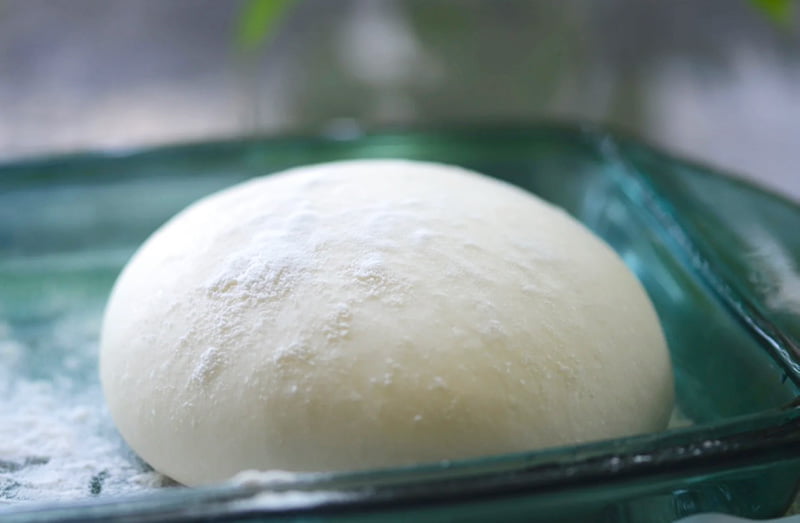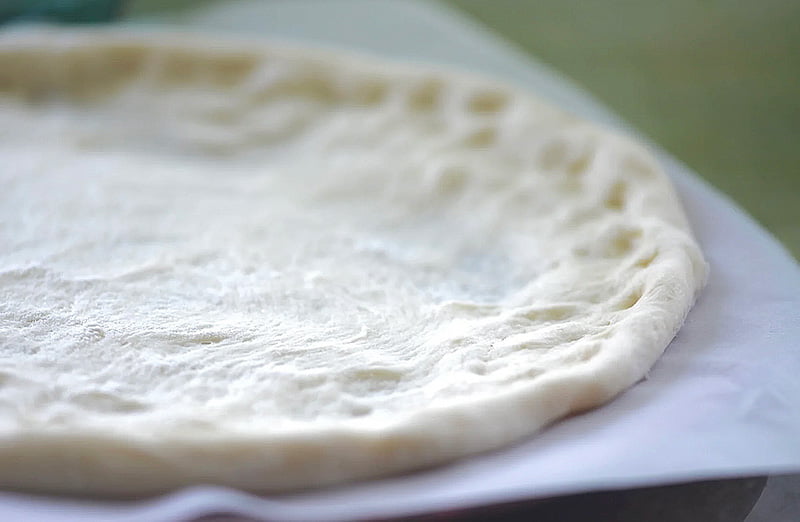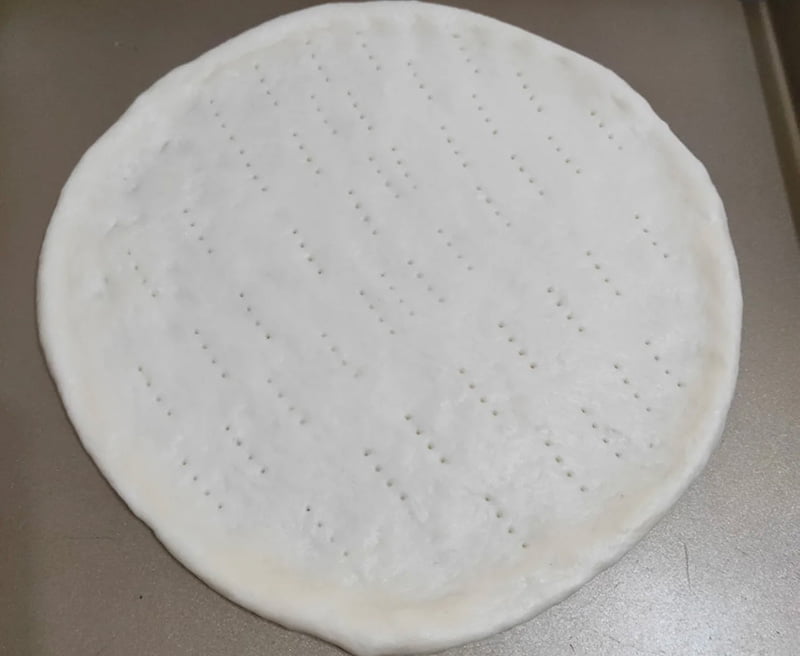There's something magical about the aroma of fresh-baked pizza, filling the air with a tantalizing mix of dough, cheese, and savory toppings. While ordering pizza from your favorite joint might be convenient, there's no denying the unparalleled satisfaction of crafting your own homemade pizza from scratch. But what's the foundation of every great pizza? You guessed it – the pizza dough!
In this blog post, we'll guide you through crafting your pizza dough from scratch. Many would argue that this is the best pizza dough recipe at home.
Easy Pizza Dough Recipe
Prep Time
15 minutes
Cook Time
15 minutes
Rest Time
60 minutes
Total Time
1 hour and 30 minutes
Ingredients
Directions
1. Combine the warm grass-fed milk and coconut sugar in a small bowl. Stir the mixture until the sugar dissolves, then sprinkle the yeast over it. Allow it to rest for approximately 5-10 minutes until it foams up.
2. Combine the all-purpose flour and salt in a large bowl, whisking them together thoroughly.
3. After the yeast mixture becomes foamy, transfer it to the flour and salt bowl. Additionally, incorporate the olive oil into the mixture.
4. Combine all the ingredients until they form a rough dough. Next, place the dough on a lightly floured surface and knead it for approximately 8-10 minutes until it becomes smooth and elastic. Alternatively, you can use a stand mixer with a dough hook attachment to knead the dough.

5. Put the dough into a lightly greased or floured bowl and then cover it with a damp cloth or plastic wrap. Let it rise in a warm, draft-free area during winter or at room temperature during summer time for about 1 to 1.5 hours or until it has doubled in size.
6. Preheat your oven or pizza oven to 475°F. If you have a pizza stone, place it in the oven during the preheating process.
7. After the dough has doubled in size, gently punch it down to release the air. Then, you can divide the dough ball into four equal portions, perfect for making four small- 12" pizzas, two medium pizzas, or keep it intact for a single large pizza. Roll out the dough on a floured surface with either flour or cornmeal and roll out to your desired thickness. You also have the option of using your hand instead if a roller is not available. To stretch by hand, gently pull and stretch the edges of the dough until it reaches the desired shape, size, and thickness. It would be best if you pulled gently to prevent any tearing.

8. Move the rolled-out dough onto a pizza peel or pizza pan. You have the option to line it with a baking sheet or parchment paper. Gently pinch the edges of the dough to form a pizza crust.
9. Use a fork and poke a few areas on the dough. This will prevent any bubbling while homemade pizza is baking. Then, brush the surface of the dough with extra virgin olive oil.

10. Spread your preferred pizza sauce, cheese, and toppings over the dough. With care, slide the pizza onto the preheated pizza stone in the oven or directly place the baking sheet on the oven rack. Bake for approximately 10-15 minutes or until the crust turns golden brown and the cheese becomes bubbly and thoroughly melted.
Tips & Notes
Properly Activate the Yeast: Before using the yeast, check its expiration date to ensure it is still active. When activating the yeast, use warm grass-fed milk (around 110°F or 45°C) with coconut sugar. Warm the milk to a suitable temperature, avoiding excessive heat, as very hot milk can potentially kill the yeast. Let the yeast mixture sit for a few minutes until it becomes foamy, indicating that it is active and ready to use.
Allow Proper Rising Time: Let the dough rise in a warm, draft-free location for approximately 1 to 1.5 hours or until it doubles in size during the first rise. If you have the luxury of time, refrigerate it overnight for enhanced flavor development.
Nutritional Facts
Nutrition Facts
Servings: 4
Calories
366
% Daily Value*
Total Fat 8.4g
11%
Saturated Fat 1.4g
7%
Cholesterol 2mg
1%
Sodium 606mg
26%
Total Carbohydrate 61.5g
22%
Dietary Fiber 3.3g
12%
Total Sugars 5.6g
Protein 11.4g
Vitamin D 24mcg
199%
Calcium 70mg
5%
Iron 4mg
24%
Potassium 279mg
6%
*The % Daily Value (DV) tells you how much a nutrient in a food serving contributes to a daily diet. 2,000 calorie a day is used for general nutrition advice.
Knead the Dough Well: Thoroughly kneading the dough is vital for gluten development, resulting in a stretchy, elastic texture. If kneading by hand, aim for about 8-10 minutes of kneading until the dough becomes smooth and bounces back when pressed with your finger. When using a stand mixer with a dough hook attachment, continue kneading for a similar duration until you attain the same desired texture
What Ingredients You Will Need To Make This Pizza Dough Recipe
All-Purpose Flour
This is the primary dry ingredient in this pizza dough recipe. Its protein content provides structure and texture to the dough. The proteins, glutenin and gliadin, form gluten when mixed with water and kneaded, giving the dough its elasticity and chewiness.
If all-purpose flour is unavailable, you can substitute it with bread flour for this pizza dough recipe. Bread flour has a higher protein content, leading to a slightly chewier crust. You can experiment with a gluten-free all-purpose flour blend for a gluten-free option, but remember that the texture may vary slightly.
Active Dry Yeast
The yeast is a crucial leavening agent in the dough. It feeds on the sugars (coconut sugar in this case) and produces carbon dioxide gas during fermentation, causing the dough to rise and become light and airy.
Salt
Salt enhances the pizza dough's flavor and helps regulate yeast activity. It also strengthens the gluten structure and improves the crust's overall texture.
Coconut Sugar
Coconut sugar is an alternative sweetener to traditional sugars like white sugar or brown sugar. It adds a subtle caramel-like flavor to the dough and helps to feed the yeast during fermentation.
Brown sugar can be used as an alternative to coconut sugar. Although the taste may differ slightly, it will still offer the desired sweetening effect.
Grass-Fed Milk
While most pizza dough recipes call for warm water as the liquid of choice, we recommend using warm grass-fed milk. Using warm milk instead of hot is crucial, as the high temperature can potentially kill the yeast. You should also warm the milk, not bring it to a boil, and let it cool. If you let the milk boil, it will change the enzyme and protein content of the milk, which will change the texture of the dough.
Both milk and water can be used to hydrate the dough and activate the yeast, and the choice comes down to personal preference and dietary considerations. Here are some distinct characteristics of the pizza dough, and you can decide which liquid you should go with to make this pizza dough recipe:
Milk adds a mild, creamy, and slightly sweet flavor to pizza dough, enhancing its overall taste. Conversely, water possesses a neutral flavor and minimally affects the dough's taste. Using milk can result in a more flavorful crust, especially when combined with other ingredients like coconut sugar.
Pizza dough made with milk tends to have a slightly richer and tender crumb than dough made with water. The fat content in milk contributes to a softer texture in the dough, which can be desirable for those who prefer a more tender crust. While still good, water-based dough might have a chewier and lighter texture.
Due to the sugar content in milk (lactose), pizza dough made with milk may brown more quickly during baking, giving it a slightly caramelized appearance. This contributes to the visual attractiveness of the crust. Water-based dough, lacking the sugars from milk, may not brown as deeply.
Water serves as a suitable replacement for milk for those with lactose intolerance or adhering to a vegan diet. Water-based dough is also good for those who prefer a simpler, more traditional pizza crust.
Olive Oil
Olive oil enriches the dough, lending it a tender texture, and further assists in achieving a beautifully browned pizza crust during baking.
Pizza Toppings
Add your favorite toppings to your homemade pizzas. You can utilize store-bought pizza sauce or create your own by combining crushed tomatoes, olive oil, garlic, and herbs. Common pizza recipes include pizza sauce, shredded mozzarella cheese or sliced fresh mozzarella, vegetables, meats, and herbs.
Why Homemade Pizza Dough?
Unmatched Freshness: When you make pizza dough at home, you have complete control over the quality and freshness of the ingredients. You can handpick the finest flour, use premium olive oil, and opt for organic yeast, ensuring every bite is unparalleled fresh.
Customization Galore: Homemade pizza dough is a blank canvas waiting to be personalized with your favorite flavors. You can experiment with different types of flour, add herbs and spices, or even infuse the dough with garlic powder for a unique twist. The possibilities are boundless, limited only by your imagination!
Health and Dietary Considerations: You can cater to specific dietary requirements by crafting your pizza dough. Whether you prefer whole-grain flour, need a gluten-free option, or wish to reduce sodium content, homemade pizza dough allows you to align the recipe with your nutritional needs.
Artisanal Touch: Making pizza dough from scratch is an artisanal process that connects you to the age-old tradition of bread making. The rhythmic kneading, the rising dough's aroma, and the creation's transformative act elevate the cooking experience.
Versatility Beyond Pizza: Don't limit yourself to traditional pizzas alone! With homemade pizza dough, you can explore a world of culinary delights, from calzones and stromboli to breadsticks and focaccia.
Cost-Effectiveness: Making your own pizza dough can be cost-effective, especially if you plan to make pizza regularly. The initial ingredient investment can often yield multiple batches, making it more budget-friendly in the long run.
Frequently Asked Questions (FAQ)
Can I make pizza dough in advance?
Yes, pizza dough can be made in advance and refrigerated or frozen for later use. Transfer the dough to an airtight container for refrigeration and store it in the refrigerator for 2-3 days. To freeze the dough, tightly wrap it in plastic wrap or place it in a freezer-safe bag and store it for up to 1-2 months. When using frozen dough, thaw it in the refrigerator overnight before utilizing it.
How long does pizza dough need to rise?
The rising time for pizza dough varies depending on the homemade pizza dough recipe and the ambient temperature. This pizza dough recipe will take approximately 1 to 1.5 hours for the dough to double in size.
Can I use whole wheat flour for pizza dough?
Certainly, you can use whole wheat flour to create pizza dough. Nevertheless, remember that whole wheat flour has a higher fiber content, which may yield a denser crust. You might need to adjust the liquid content and kneading time to compensate. Another option is to blend whole wheat and all-purpose flour, balancing flavor and texture.
What's the best way to roll out pizza dough?
To roll out pizza dough, sprinkle a clean surface lightly with flour or cornmeal, and then use a rolling pin to flatten the dough to your preferred shape and thickness. Alternatively, you can stretch the dough with your hands by gently pulling and rotating it.
Do I need a pizza stone to make pizza at home?
Although a pizza stone can contribute to a crispy crust, it is not an absolute requirement. You can use a preheated baking sheet or even a cast-iron skillet as an alternative.
What's the best way to store leftover pizza dough?
To preserve any leftover pizza dough, place it in an airtight container or wrap it with plastic wrap, and store it in the refrigerator for up to 2-3 days. Alternatively, freeze the dough for up to 1-2 months.
Can I freeze pizza dough?
You can make the pizza dough ahead of time and freeze it. Once the dough has risen and formed into a ball, wrap it tightly with plastic wrap and store it in an airtight container or freezer bag. Before using, thaw the frozen dough in the refrigerator.
What can I do if the dough doesn't rise?
If the dough fails to rise, the issue could be inactive yeast or improper rising conditions. Verify the yeast's expiration date and ensure that the liquid used for proofing is warm but not overly hot. Also, let the dough rise in a warm, draft-free environment.
